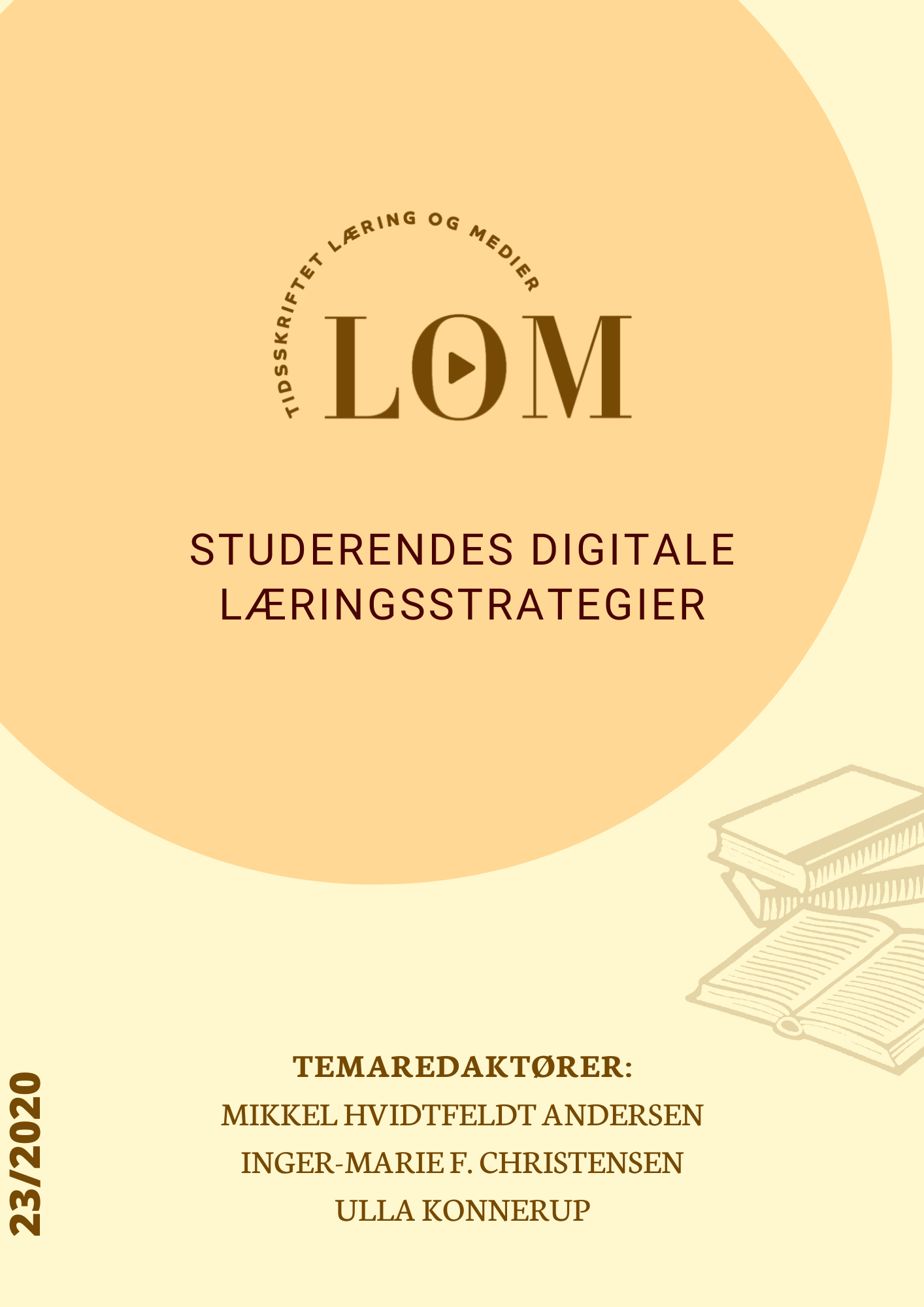Digital texts and written language in upper secondary education: A curriculum perspective
DOI:
https://doi.org/10.7146/lom.v13i23.120963Keywords:
digital texts, genre, register, written language, curriculum, upper secondary educationAbstract
Over the last few decades, digital text formats have become by far the most common. In this article, I discuss the consequences of this massive digital transformation for our conception of texts and text quality, and I discuss the possible consequences for L1 writing pedagogy in secondary education. The article has three parts. Firstly, I discuss differences and similarities between digital and non-digital text formats, secondly, I show how a functional approach to text and genre analysis can lead to a better understanding of text quality, and finally, I discuss the possible implications of this view for L1 writing pedagogy in secondary education.
Downloads
References
Andersen, H. C. (1844). Nattergalen. I Nye Eventyr. Reitzels Forlag.
Askehave, I., & Swales, J. M. (2001). Genre identification and communicative purpose: A problem and a possible solution. Applied Linguistics, 22(2), 195–212. https://doi.org/10.1093/applin/22.2.195
Baron, N. S. (2008). Always on: Language in an online and mobile world. Oxford University Press.
Berry, D. M. (2012). Introduction: Understanding the Digital Humanities. I D. M. Berry (Red.), Understanding Digital Humanities (1st ed. 2012., s. 1–20). Palgrave Macmillan UK.
Berthelsen, U. D., & Tannert, M. (2020). Utilizing the affordances of digital learning materials. L1 - Educational Studies in Language and Literature, 20, 1–23. https://doi.org/10.17239/L1ESLL-2020.20.02.03
Biber, D. (1995). Dimensions of register variation: A cross-linguistic comparison. Cambridge University Press.
Biber, D. (2006). University language: A corpus-based study of spoken and written registers. JBenjamins.
Biber, D., & Conrad, S. (2009). Register, genre, and style. University Press.
Biber, D., & Egbert, J. (2018, august). Register Variation Online. Cambridge Core. https://doi.org/10.1017/9781316388228
Børne- og Undervisningsministeriet. (u.å.). Stx—Læreplaner 2017. Hentet 7. januar 2020 fra https://www.uvm.dk:443/gymnasiale-uddannelser/fag-og-laereplaner/laereplaner-2017/stx-laereplaner-2017
Børne- og Undervisningsministeriet. (2017). Stx—Læreplaner. Hentet 7. januar 2020 frahttps://www.uvm.dk:443/gymnasiale-uddannelser/fag-og-laereplaner/laereplaner-2017/stx-laereplaner-2017
Børne- og Undervisningsministeriet. (2019a). Dansk A, stx. Vejledning. Hentet 7. januar 2020 fra https://www.uvm.dk:443/gymnasiale-uddannelser/fag-og-laereplaner/laereplaner-2017/stx-laereplaner-2017
Børne- og Undervisningsministeriet. (2019b). Råd og Vink 2019—Til de nye genrer, skriftlig dansk stx. EMU.dk. Hentet 7. januar 2020 fra https://emu.dk/sites/default/files/2019-10/R%C3%A5d%20og%20vink%202019%20Dansk%20A%20Hf%20%28002%29.pdf
Crystal, D. (2001). Language and the internet. Cambridge University Press.
Crystal, D. (2008). Txtng: The Gr8 Db8. Oxford University Press.
de Beaugrande, R. (1993). “Register” in discourse studies: A concept in search of a theory. I M. Ghadessy (Red.), Register analysis: Theory and Practice. Pinter Publishers.
de Kunder, M. (u.å.). WorldWideWebSize.com | The size of the World Wide Web (The Internet). Hentet 13. januar 2020, fra https://www.worldwidewebsize.com/
Ehala, M. (2018). Social Media, Culture, and Identity Construction: From Mass Communication to Communication of the Masses. Routledge.
Fischer, S. R. (2001). A history of writing. Reaktion Books.
Gibson, J. J. (1979). The ecological approach to visual perception. Houghton Mifflin.
Halliday, M. A. K. (1978). Language as social semiotic: The social interpretation of language and meaning. Edward Arnold.
Halliday, M. A. K. (1985). An introduction to functional grammar. Edward Arnold.
Halliday, M. A. K., & Hasan, R. (1976). Cohesion in English. Longman.
Harris, R. (2001). Rethinking writing. Continuum.
Hemmingsen, A. (2017). Den store Tinderbog: 200 gale eller geniale scoringsforsøg på Tinder.. People’sPress.
Hetmar, V. (2011). Kommunikationsformer som didaktisk kategori. Cursiv, 7(2), 75–96.
Hutchby, I. (2001). Technologies, Texts and Affordances. Sociology, 35(2), 441–456. https://doi.org/10.1177/S0038038501000219
Hutchby, I. (2014). Communicative affordances and participation frameworks in mediated interaction. Journal of Pragmatics, 72, 86-89.
Kern, R. (2015). Language, Literacy, and Technology. Cambridge University Press.
Kress, G. (2006). Literacy in the new media age. Routledge.
Kress, G. (2010). Multimodality: A social semiotic approach to contemporary communication. Routledge.
Leeuwen, T. van. (2005). Introducing social semiotics. Routledge.
Leiner, B. M., Cerf, V. G., Clark, D. D., Kahn, R. E., Kleinrock, L., Lynch, D. C., Postel, J., Roberts, L. G., & Wolff, S. (2009). A Brief History of the Internet. SIGCOMM Comput. Commun. Rev., 39(5), 22–31. https://doi.org/10.1145/1629607.1629613
Lov om dansk retskrivning. LOV nr. 332 af 14/05/1997, (1997). Hentet 7. januar 2020 fra https://www.retsinformation.dk/Forms/R0710.aspx?id=84769
Martin, J. R. (1992). English text: System and structure. John Benjamins.
Martin, J. R., & Rose, D. (2008). Genre relations: Mapping culture. Equinox.
Merchant, G. (2007). Writing the future in the digital age. Literacy, 41(3), 118–128. https://doi.org/10.1111/j.1467-9345.2007.00469.x
Nortier, J., & Svendsen, B. A. (2015). Language, youth and identity in the 21st century: Linguistic practices across urban spaces. Cambridge University Press.
Saussure, F. de. (1931). Cours de linguistique générale (A. Sechehaye, A. Riedlinger, & C. Bally, Red.). Payot.
Seargeant, P., & Tagg, C. (2013). The language of social media: Identity and community on the Internet. Palgrave Macmillan.
Searle, J. R. (1969). Speech acts: An essay in the philosophy of language. Cambridge University Press.
Swales, J. M. (1990). Genre analysis: English in academic and research settings. Cambridge University Press.
Togeby, O. (2014). Bland blot genrerne—Ikke tekstarterne!: Om sprog, tekster og samfund. Samfundslitteratur.
Undervisningsministeriet. (1971). Bekendtgørelse om undervisningen i gymnasiet og fordringerne ved og eksamensopgivelserne til studentereksamen. Nr. 322 af 16. Juni 1971. (Inkl. Ændringer via bekendtgørelse nr. 19 af 23. Januar 1975, nr. 186 af 1. April 1976 og nr. 662 af 15. December 1977). Undervisningsministeriet.
Downloads
Published
How to Cite
Issue
Section
License

Articles published in the Journal of Learning and Media are licensed under a Creative Commons Attribution-NonCommercial-NoDerivatives 3.0 Unported Licens.
Authors retain copyright and grant the journal right of first publication; simultaneously articles are licensend under the Creative Commons Attribution license: Attribution-NonCommercial-NoDerviatives (by-nc-nd). Read about this license at https://creativecommons.org/licenses/by-nc-nd/3.0/
---
At LOM.dk, you will also find articles from the discontinued Journal for the Continuing and Further Education of the Danish Universities (UNEV). Note that special rules apply to UNEV articles:
It is the authors and any other copyright holder who have the copyright of articles published under the auspices of UNEV, and access to the articles is contingent on users acknowledging and complying with the associated legal guidelines:
- Users may download and print one copy of any UNEV publication for private studies or research.
- The redistribution of articles or the use of these for revenue-funded activities or commercial purposes are not allowed.
- It is not allowed to distribute the URLs of UNEV articles.


